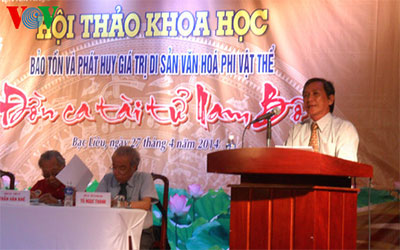A workshop discussing how to preserve and develop the musical genre “Don ca tai tu” took place in the southern province of Bac Lieu on April 27, bringing together a crowd of scholars and researchers operating in the field.

As part of the ongoing national “Don ca tai tu” festival in the locality, the event focused on analysing the art and reviewing the process of developing it.
Known as a musical art that has both scholarly and folk roots,”Don ca tai tu” developed in southern Vietnam in the late 19th century.
UNESCO recognised it as intangible cultural heritage last December during a session of the Intergovernmental Committee for the Safeguarding of the Intangible Cultural Heritage in Baku, Azerbaijan.
The art is performed at numerous events, such as festivals, ‘death anniversary' rituals and celebratory occasions. The audience can join in by offering feedback to the singers and suggesting new lyrics for songs.
It has been transmitted from generation to generation through official and unofficial forms of education in all the 21 southern provinces, where it is most popular.
The music is played on a variety of different instruments, including the kim (moon-shaped lute), co (two-stringed fiddle), tranh (16-string zither), ty ba (pear-shaped lute), song lang (percussion), bau (monochord) and sao (bamboo flute).
Musicians are classified as ‘master instrumentalists’, ‘master lyricists’, ‘master singers’, ‘instrumentalists’ and ‘singers’.
Influenced by other forms of cultural heritage from the central and southern regions of Viet Nam, such as “nhac le” (ceremonial music) and “hat boi” (classical theatre and folk song), the music genre was added to the National List of Intangible Cultural Heritage in 2012.
At the workshop, attendees said the festival aids Viet Nam’s attempts to preserve the country’s traditional art and culture.
The first event of its kind, the festival has attracted the attention of the domestic and international community and spurred a joint effort to conserve the form.